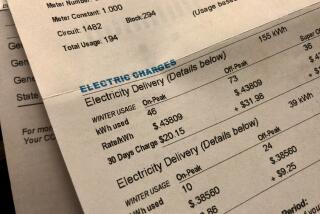PG&E; Posts 28% Drop in Profit, Lifts Forecast
- Share via
PG&E; Corp., owner of California’s largest utility, said Wednesday that second-quarter profit fell 28% compared with a year earlier, when the company had gains related to rate increases. PG&E; raised its forecast for annual profit.
Net income fell to $267 million, or 70 cents a share, from $372 million, or 88 cents, the San Francisco-based company said. Sales fell 9% to $2.5 billion.
The company’s profit a year earlier included retroactive recognition of a rate increase as its utility came out of bankruptcy. The company this year restored its dividend and laid out plans to boost profit by upgrading its electricity system, pushing the shares to an all-time high.
The company raised its forecast for 2005 profit from operations, which excludes certain items, by 5 cents a share, to a range of $2.20 to $2.30 a share. It also raised the forecast for next year by the same amount, to a range of $2.35 to $2.45.
PG&E; shares fell 14 cents to $37.86. The shares, which touched a record $38.68 on Wednesday, have risen 14% this year.
PG&E; said operating profit was 69 cents a share, compared with 70 cents a year earlier, excluding the rate increase and other items. On that basis, the average estimate of analysts surveyed by Thomson Financial was 60 cents.
The utility on Monday made a preliminary filing for a proposal to raise rates by $654 million starting in 2007 to upgrade substations and gas mains and to expand its power system for new customers. The application must be approved by the California Public Utilities Commission.
The utility has asked the commission to approve its plans to upgrade customer meters, which will require an investment of $1.25 billion. It also plans to purchase a partially completed power plant for $310 million.
The company’s Pacific Gas & Electric utility primarily serves Northern and Central California.
More to Read
Inside the business of entertainment
The Wide Shot brings you news, analysis and insights on everything from streaming wars to production — and what it all means for the future.
You may occasionally receive promotional content from the Los Angeles Times.









